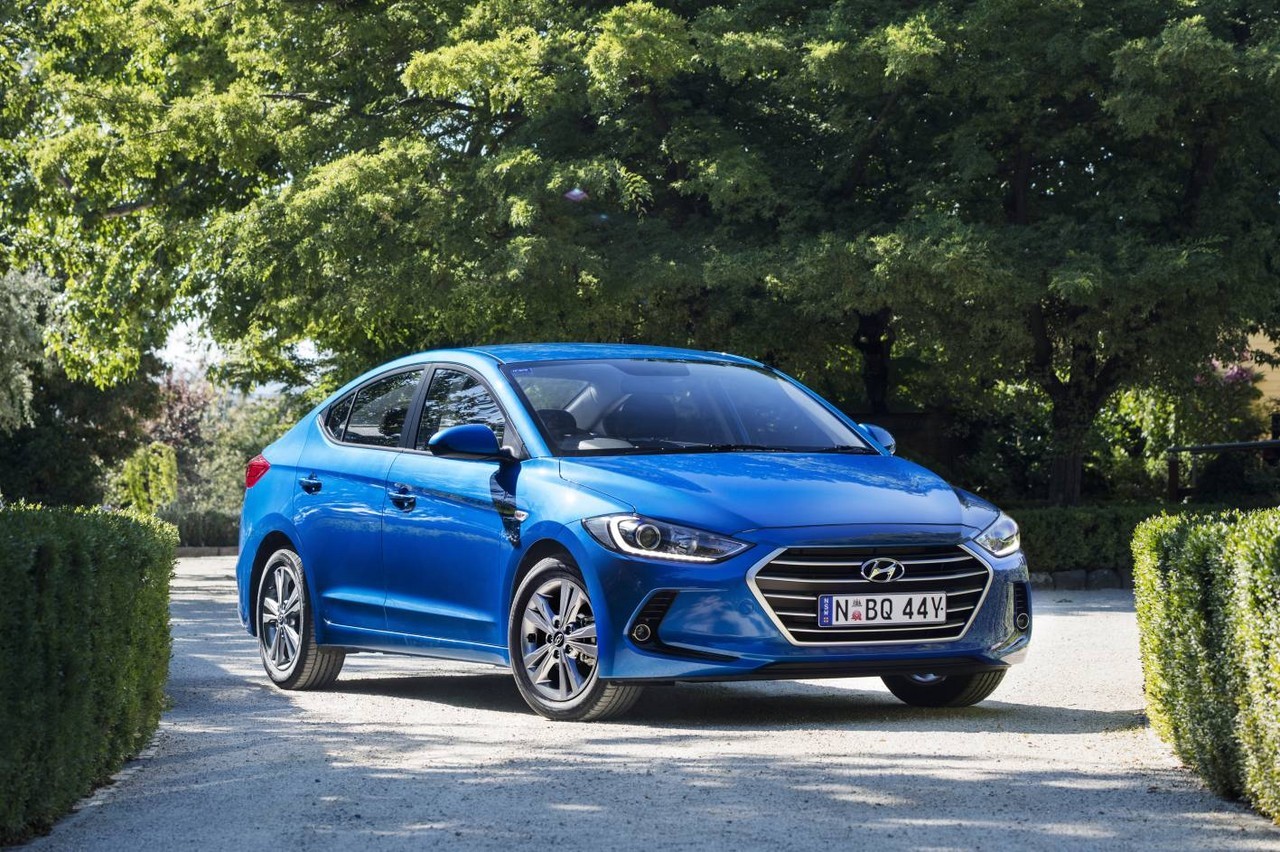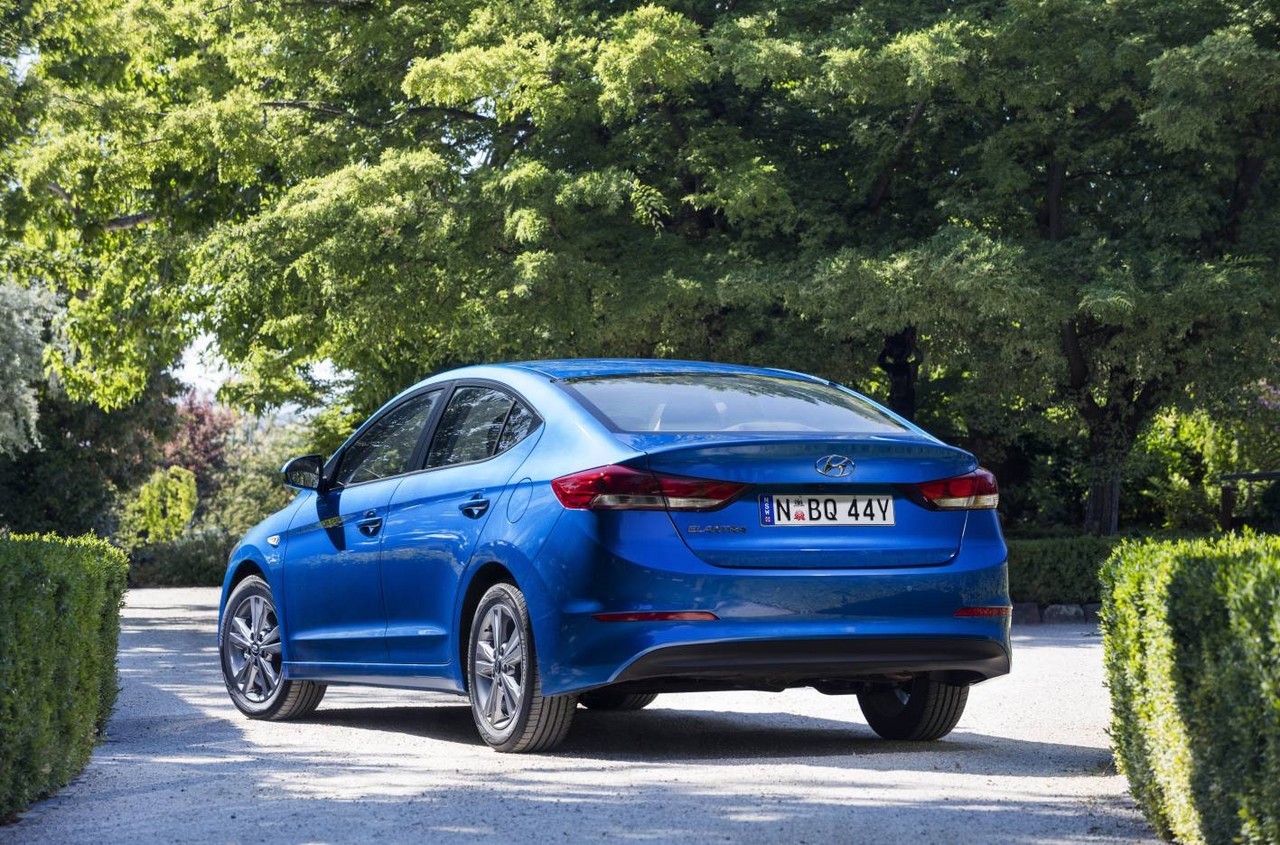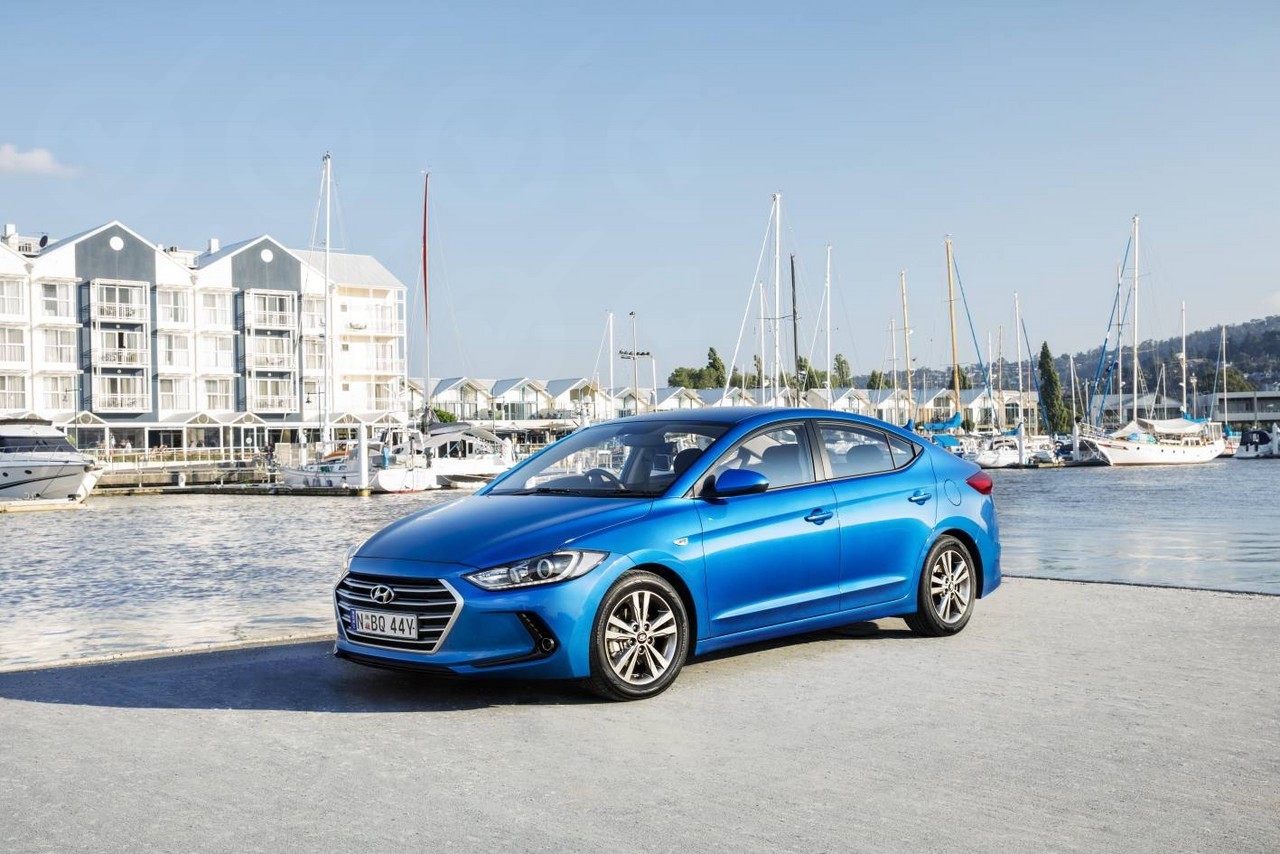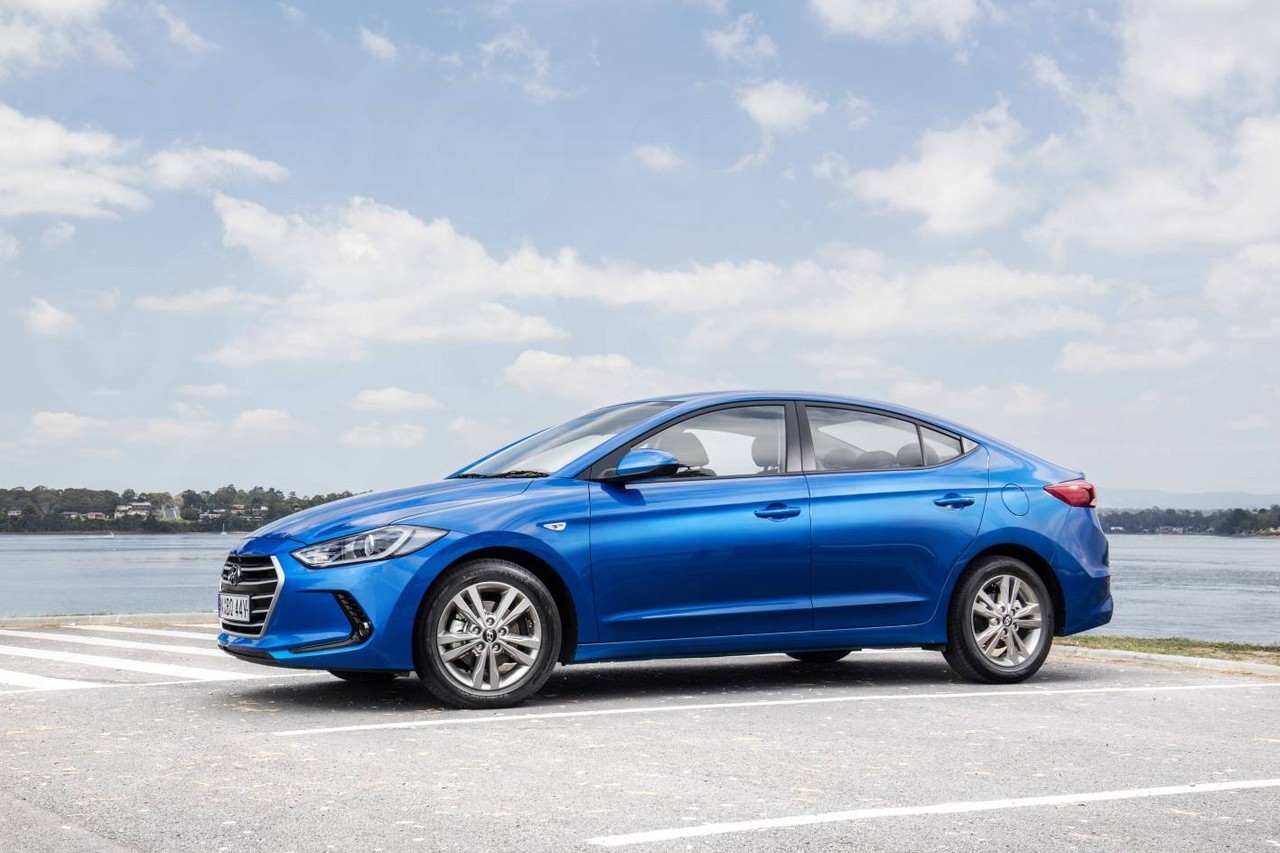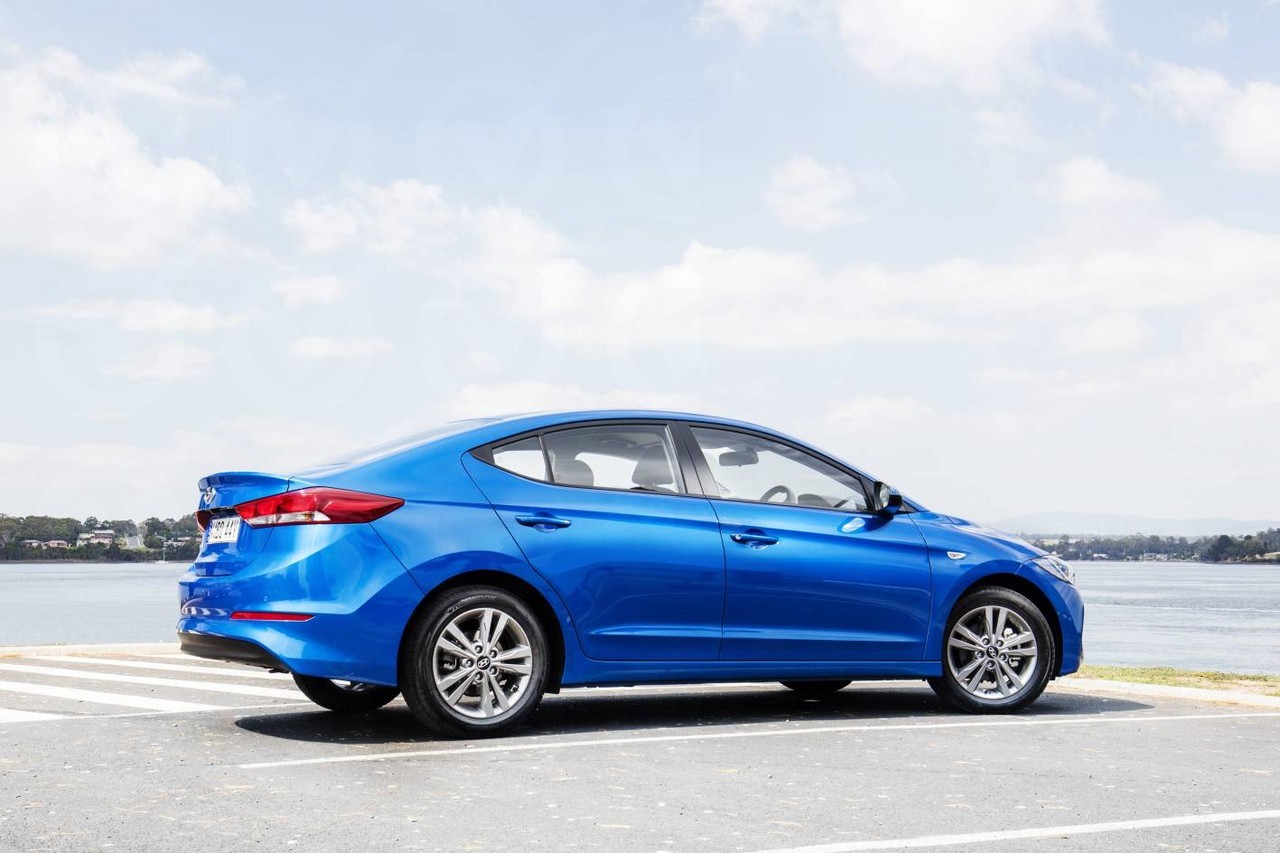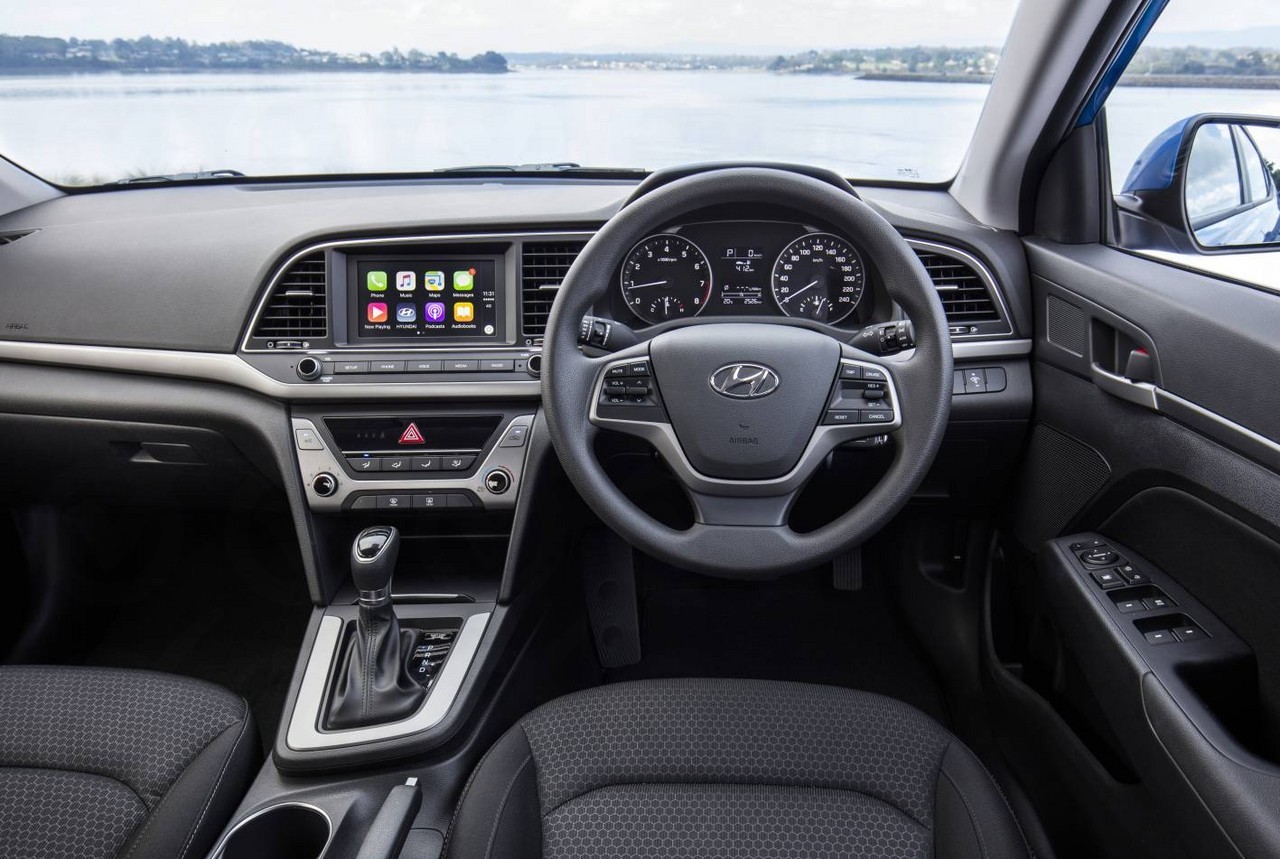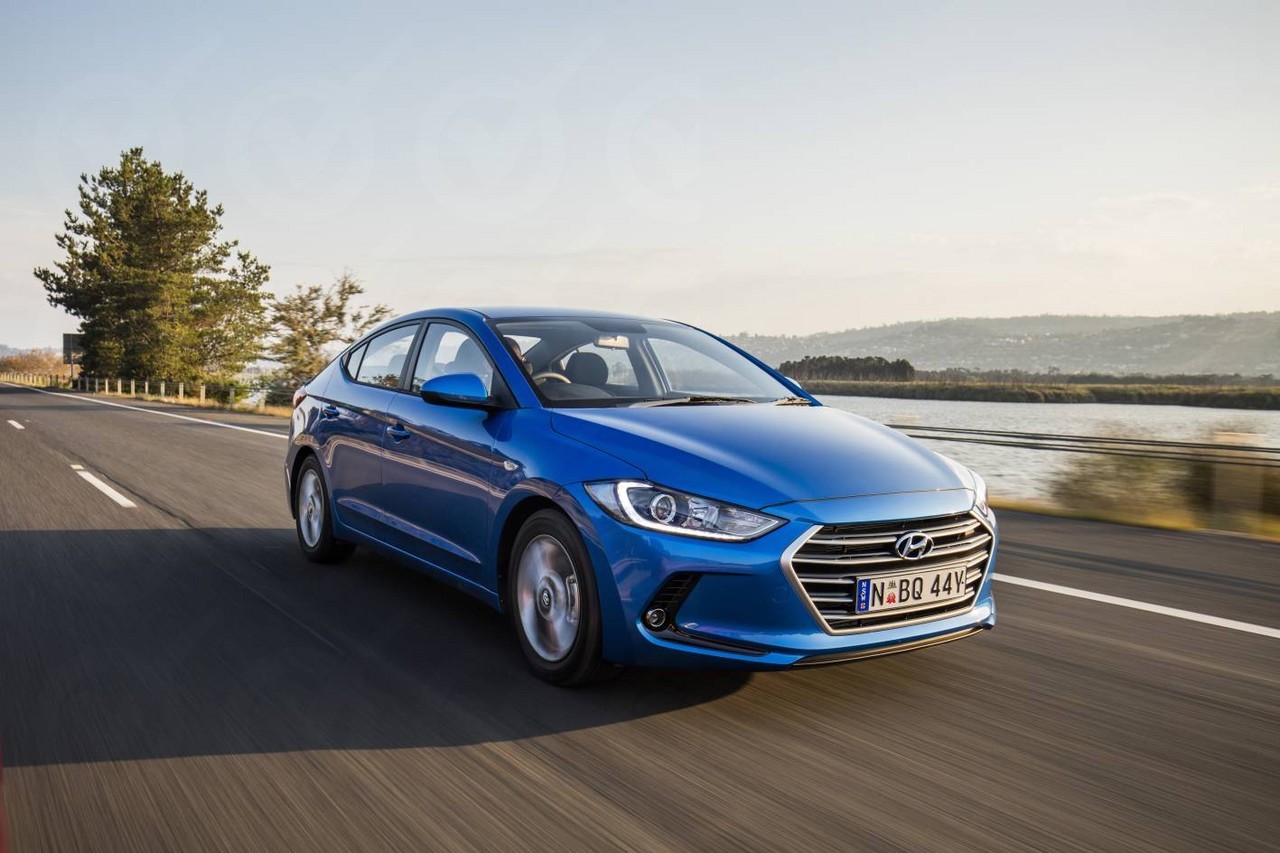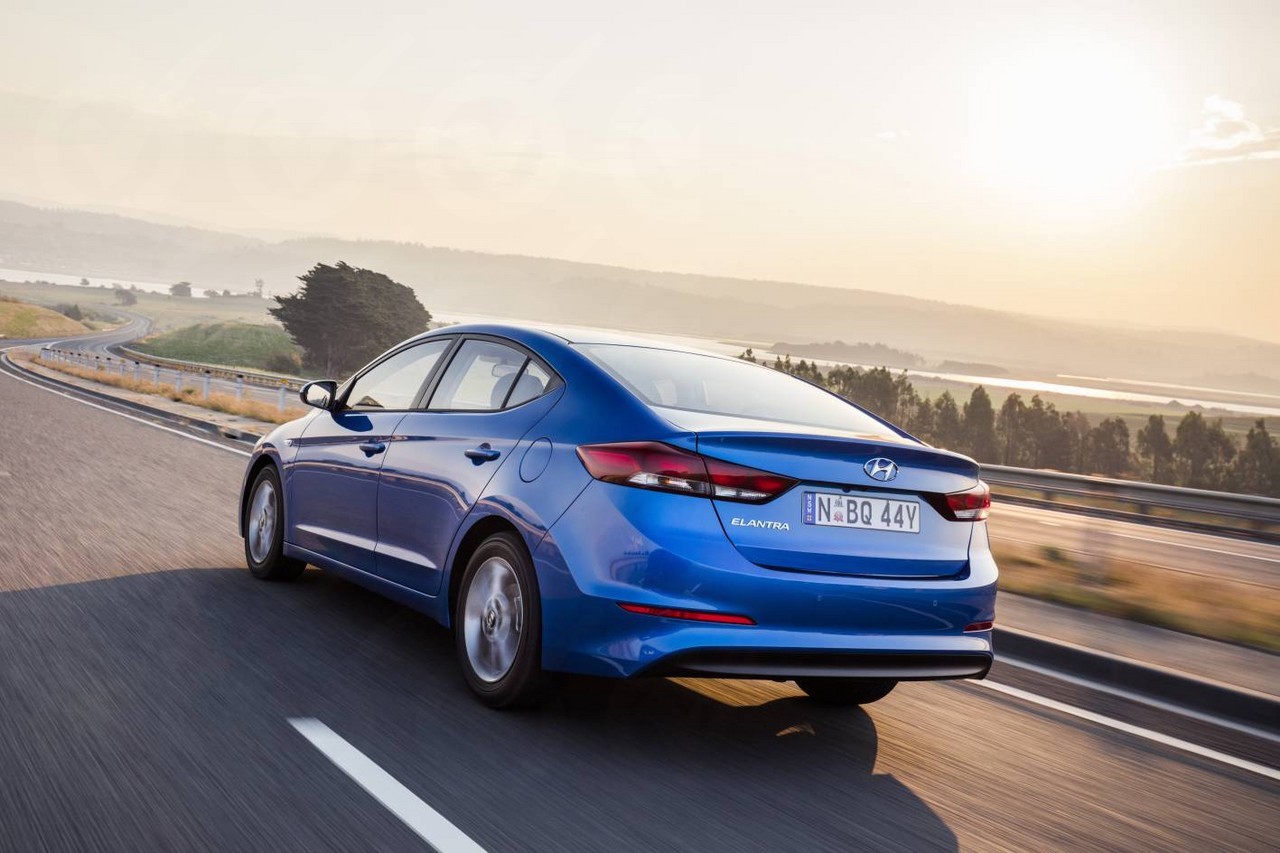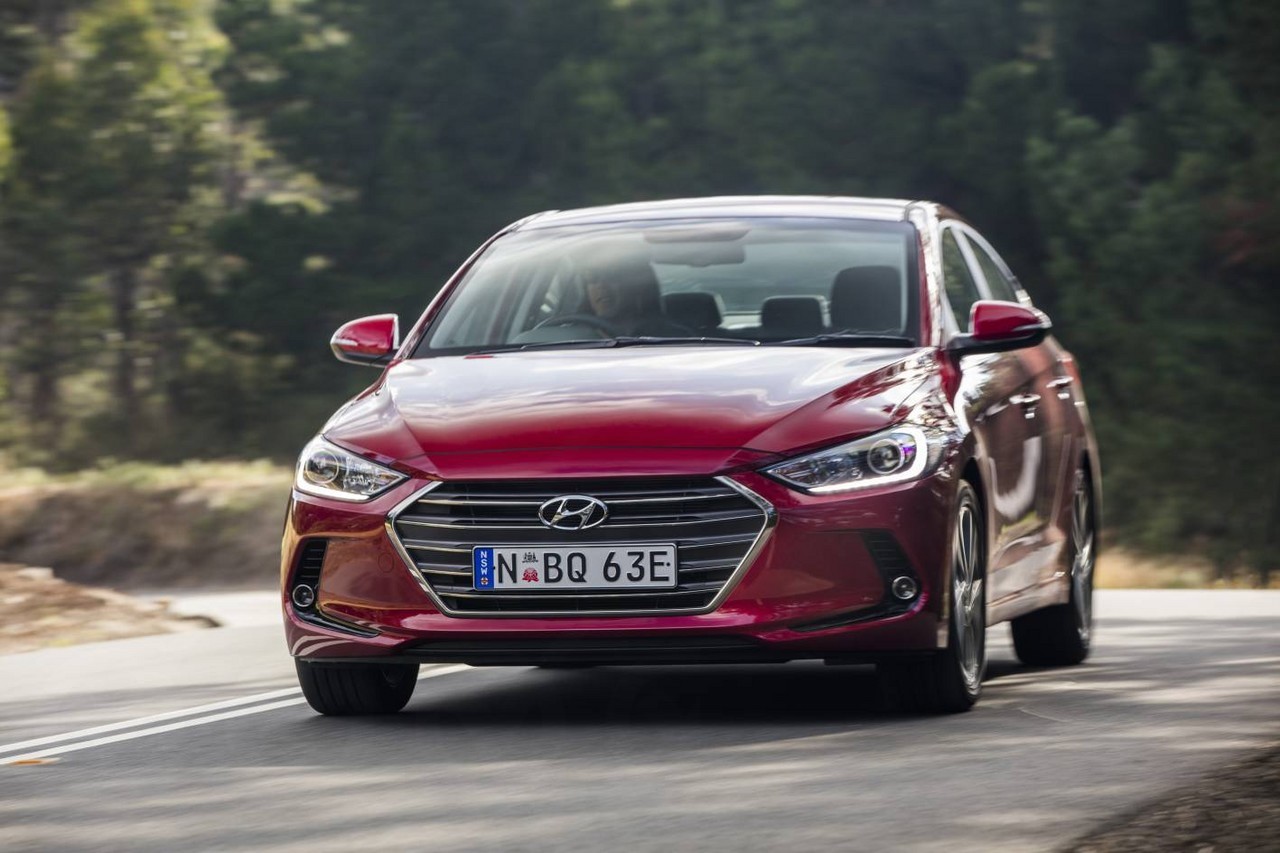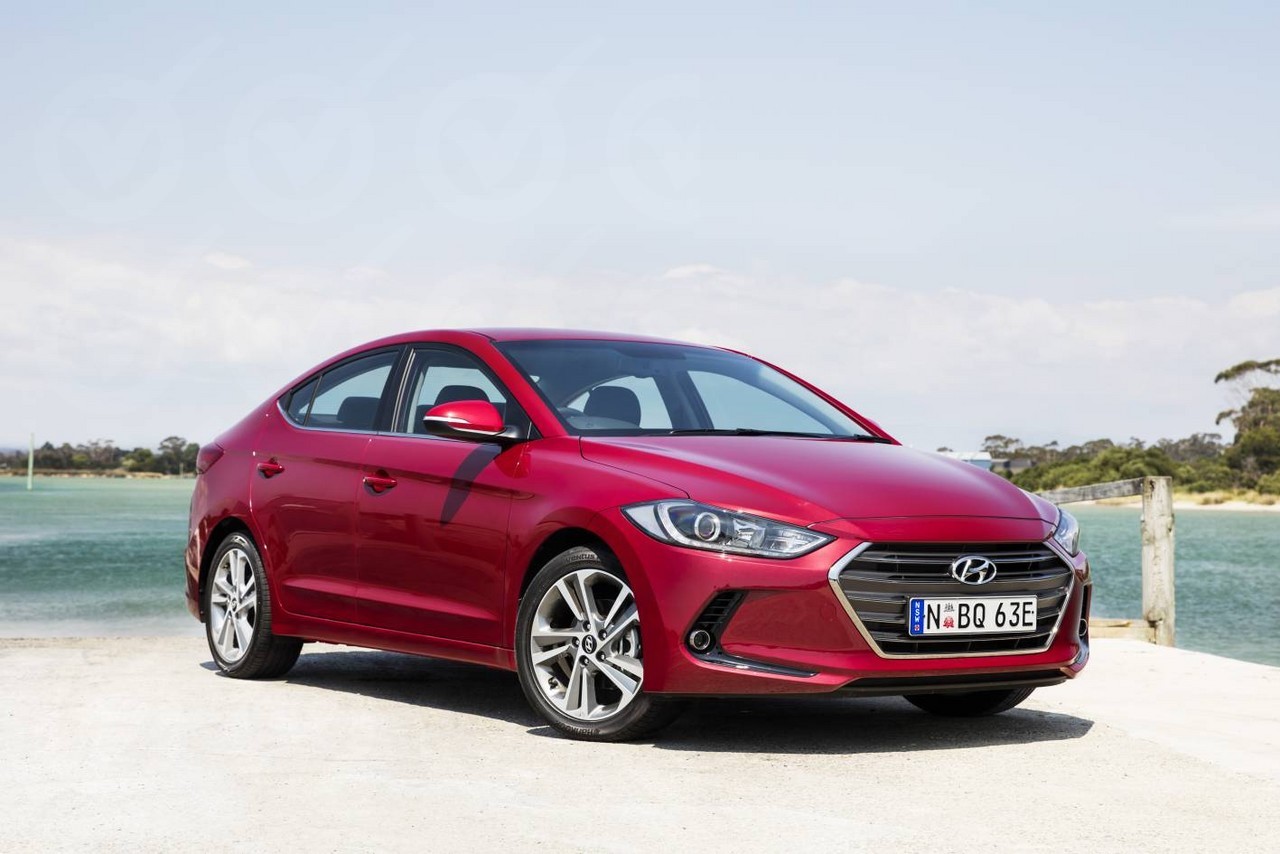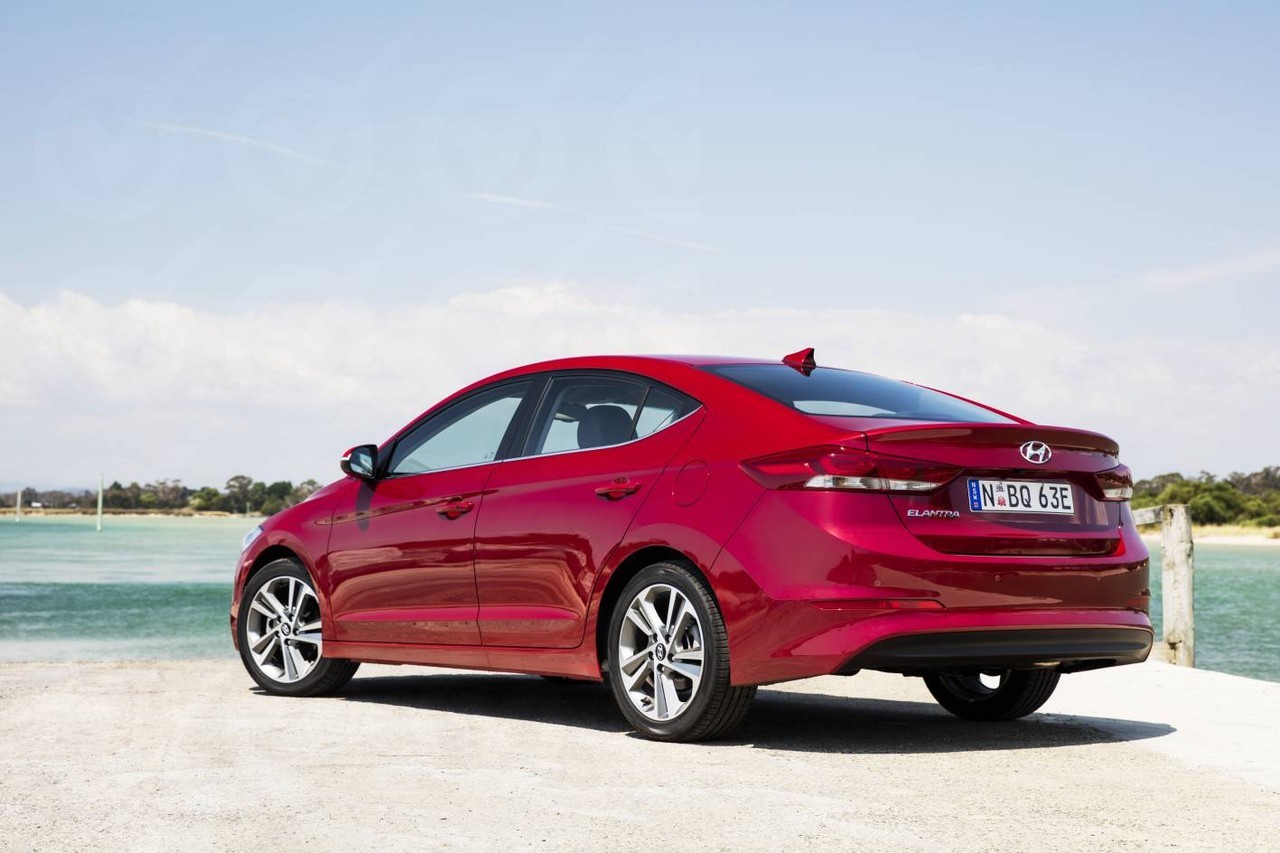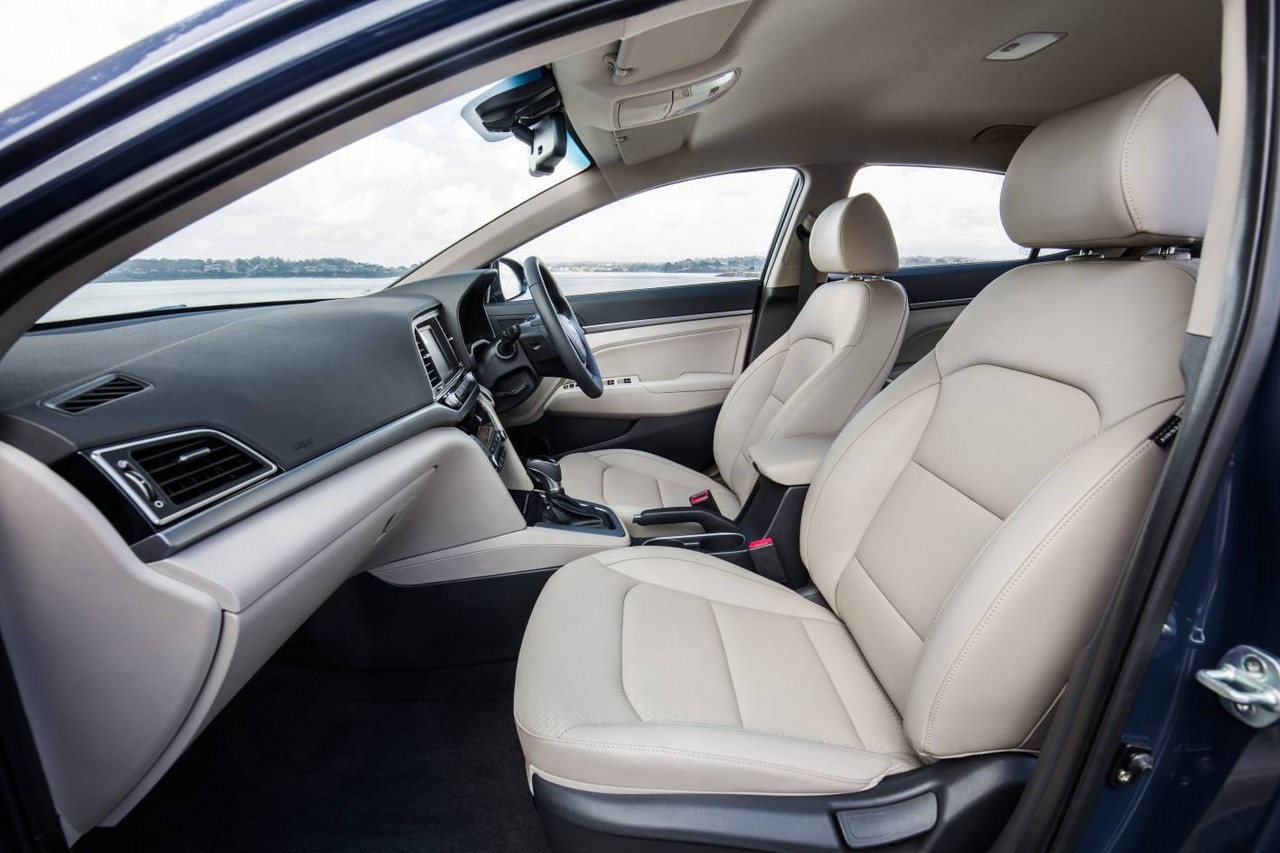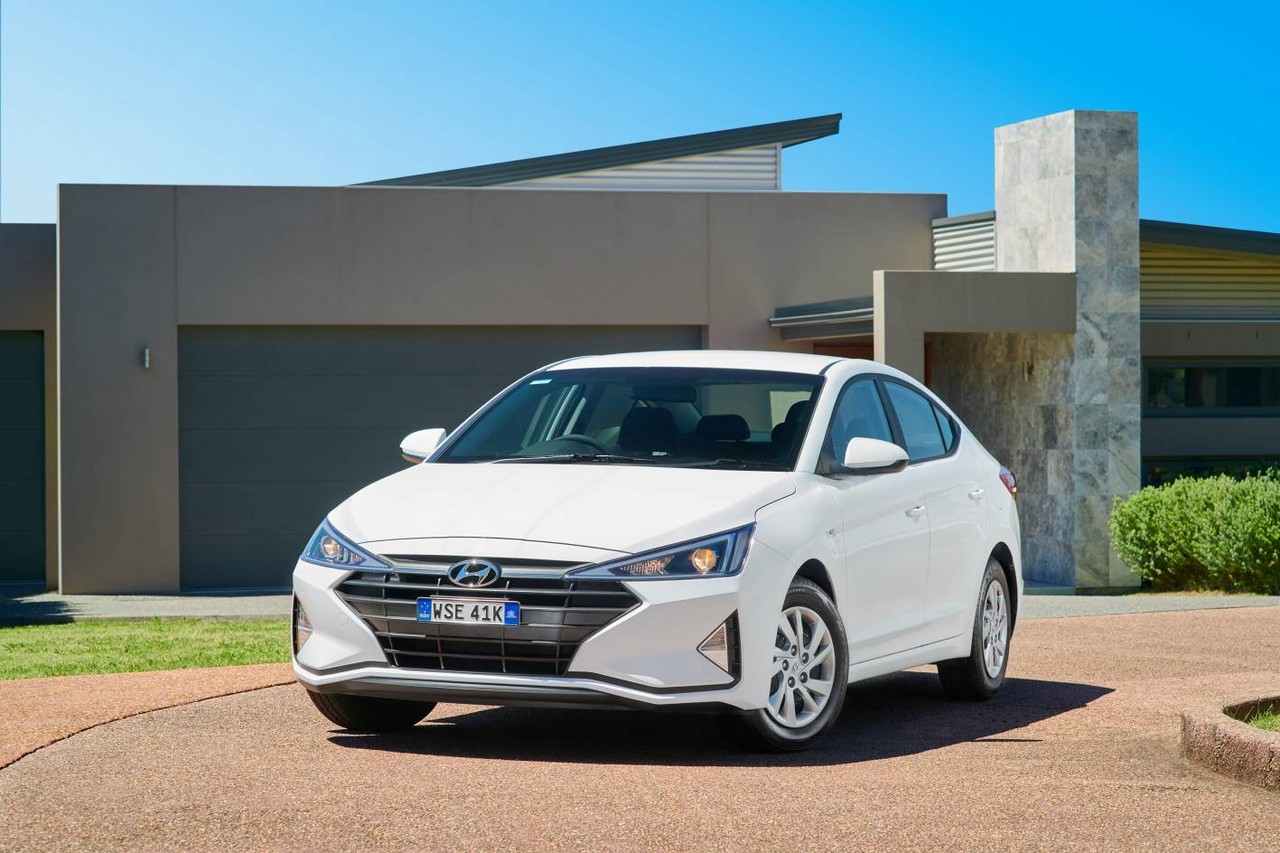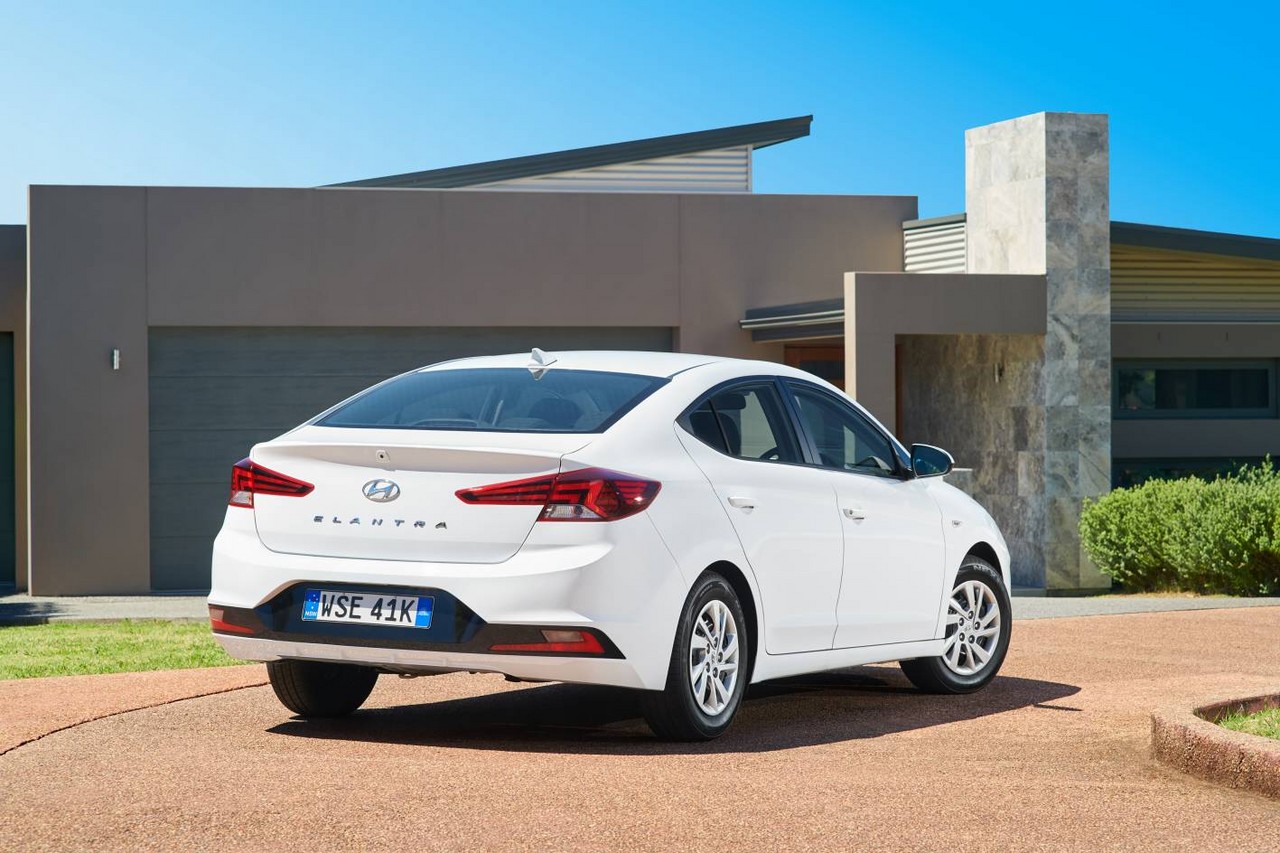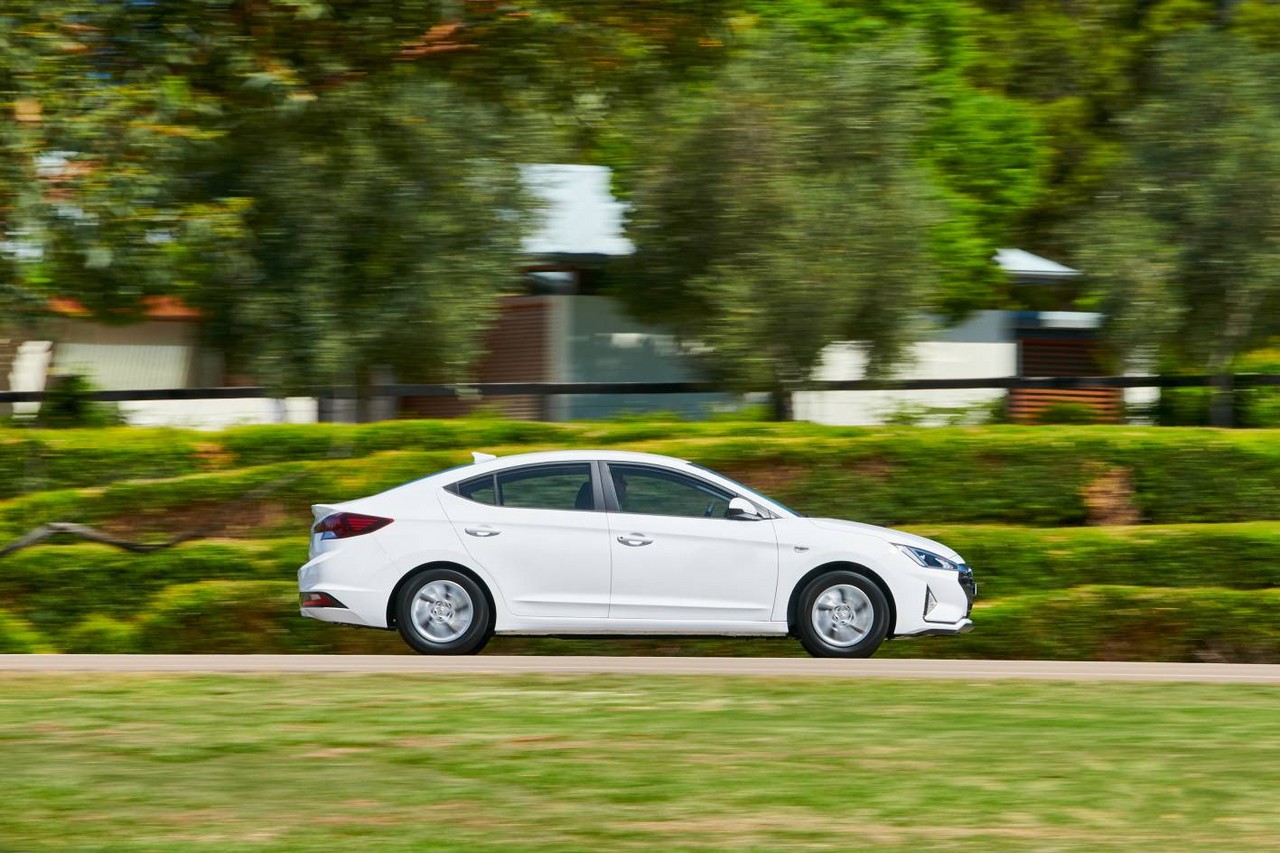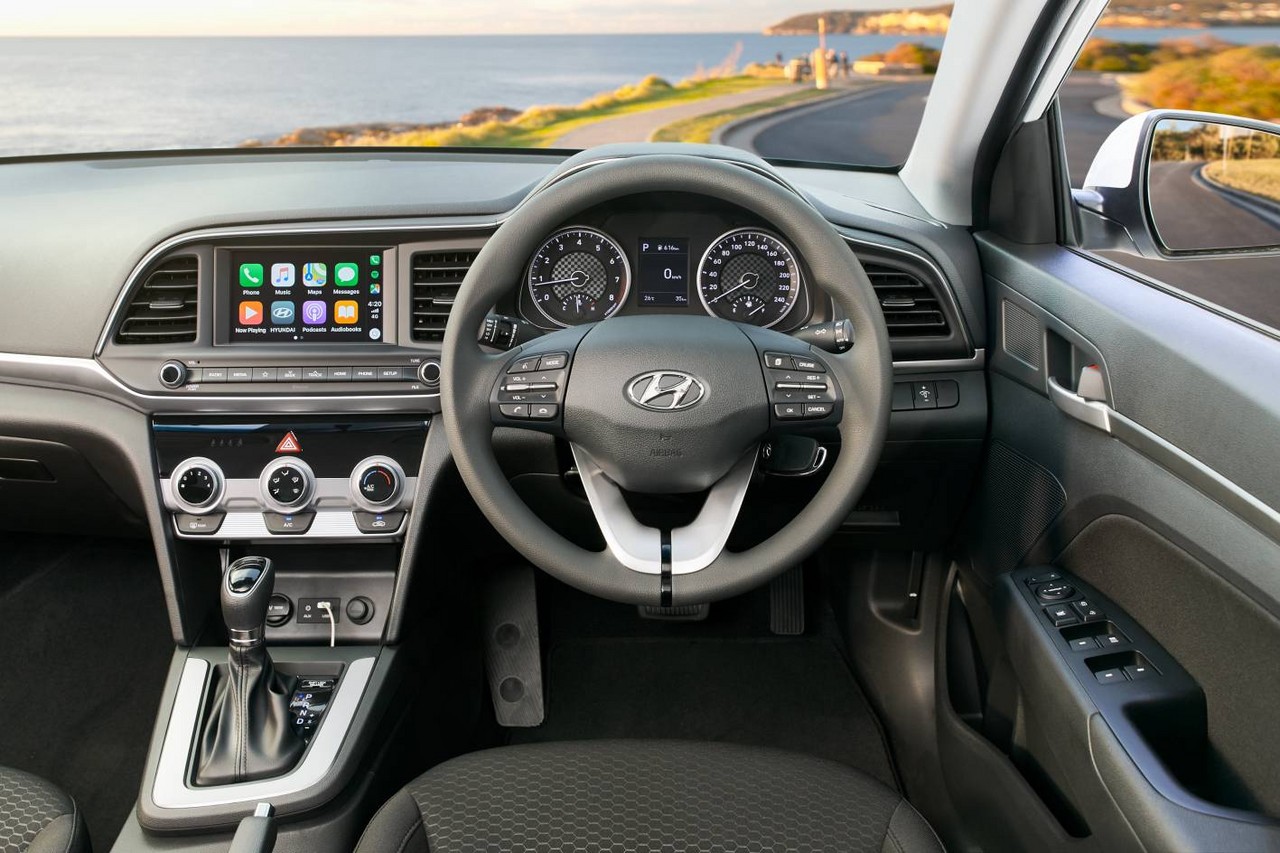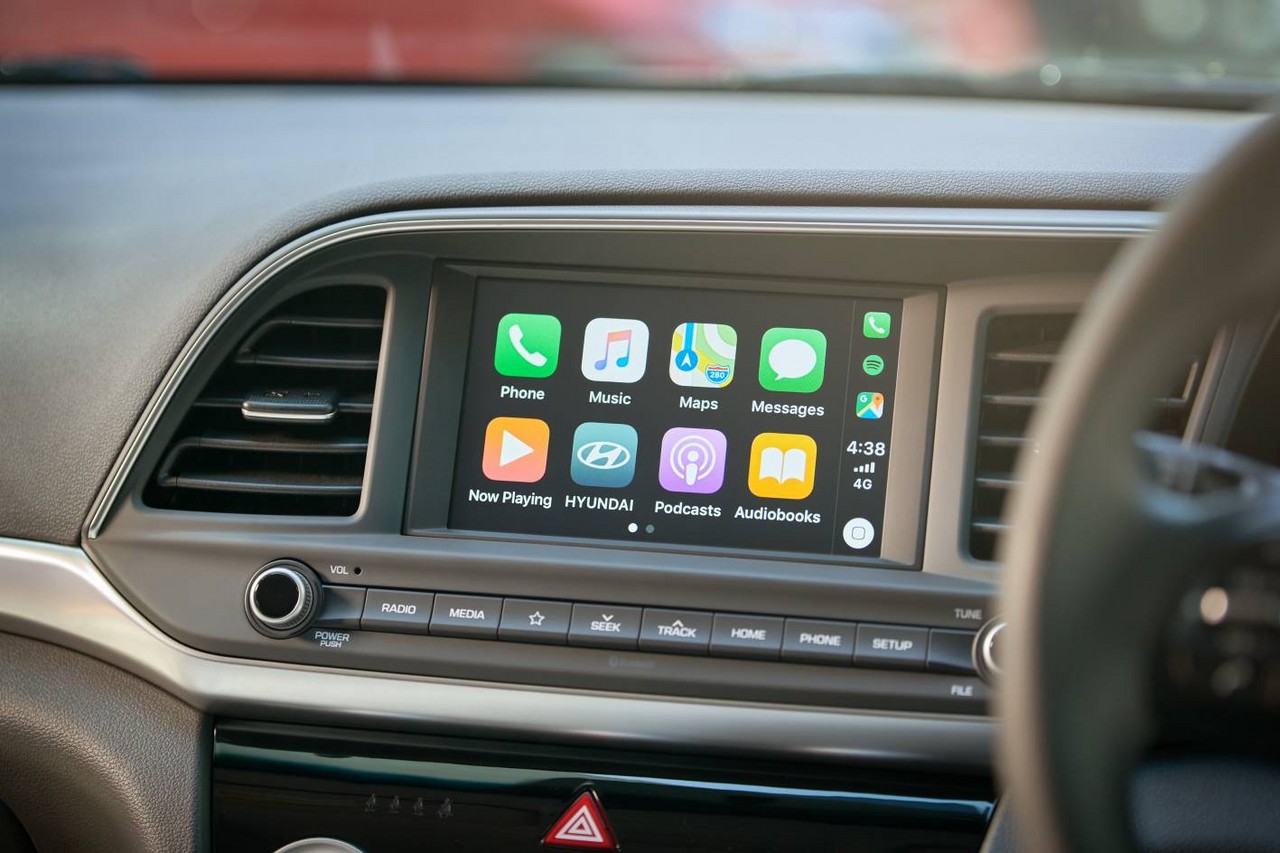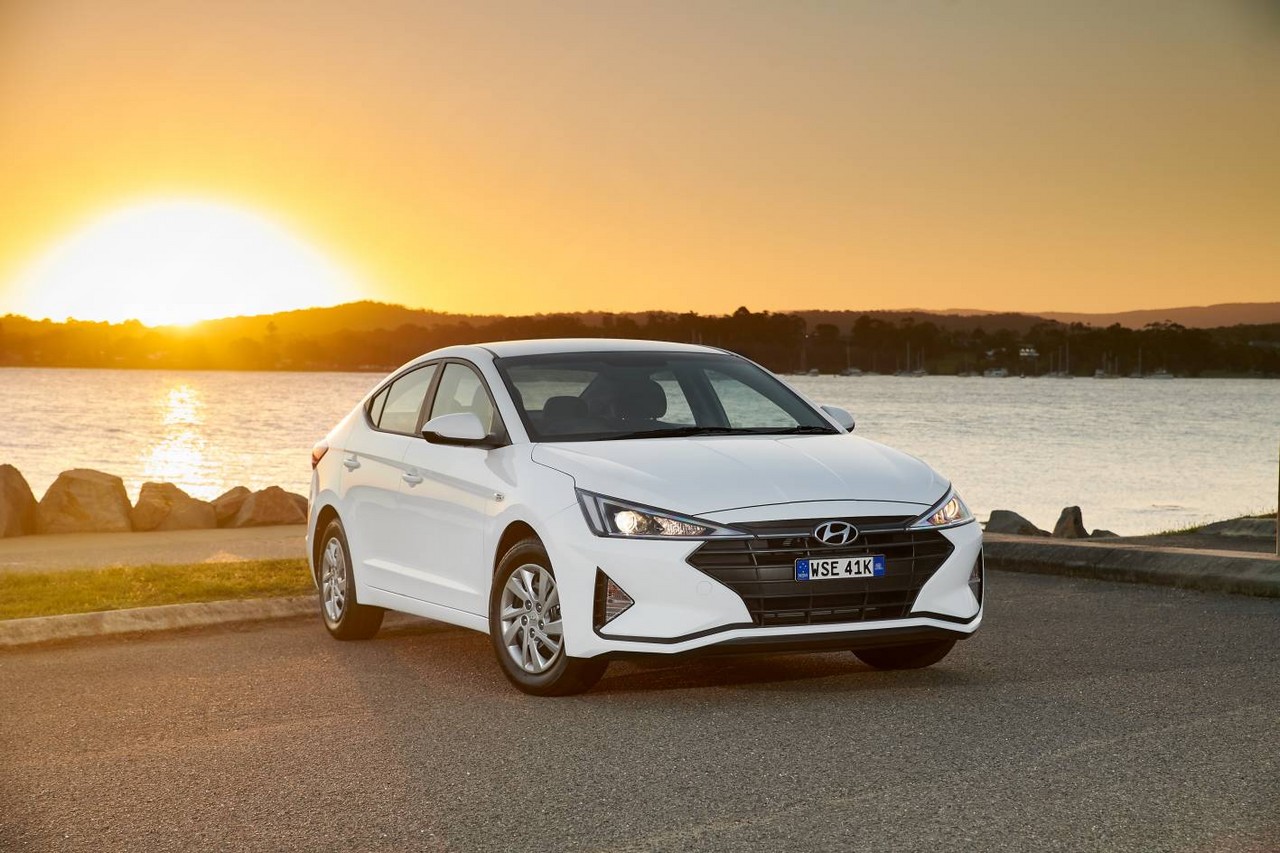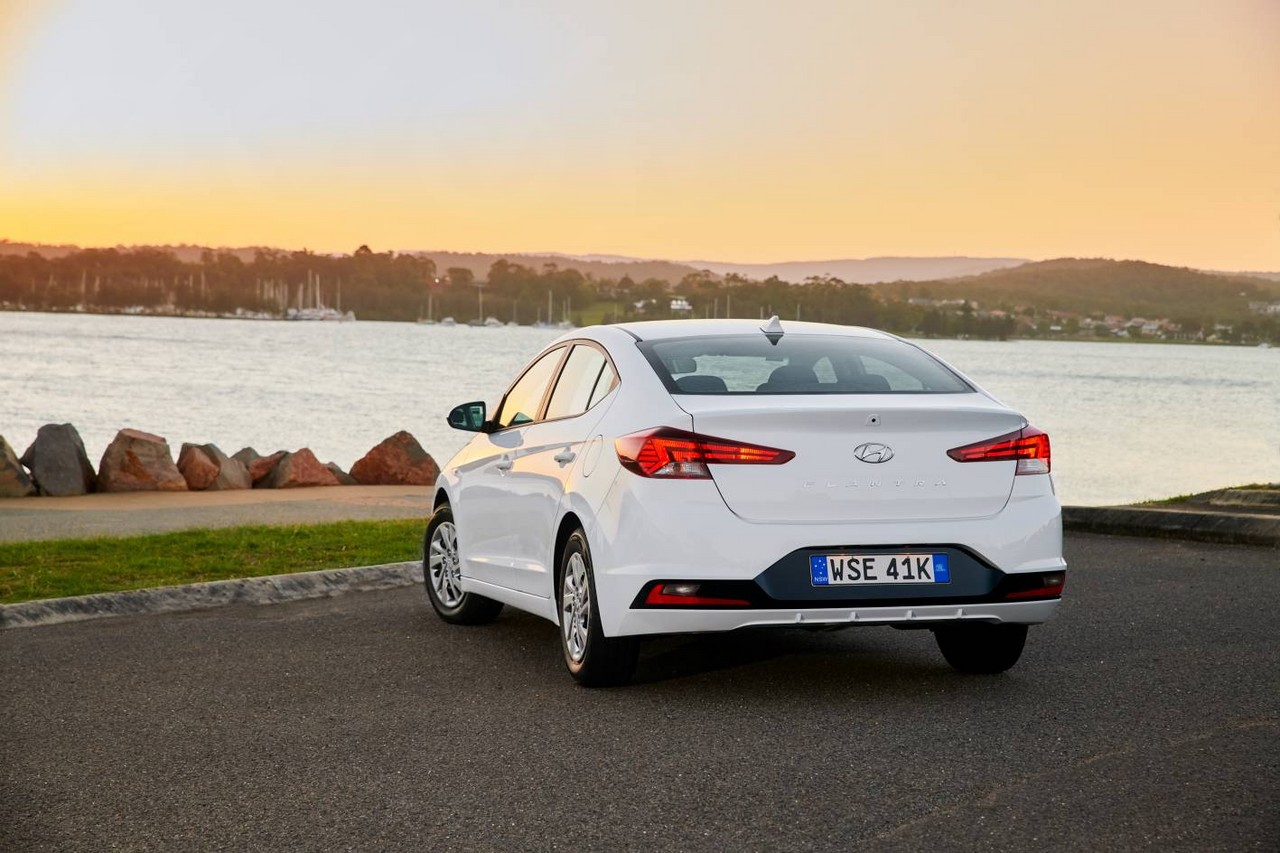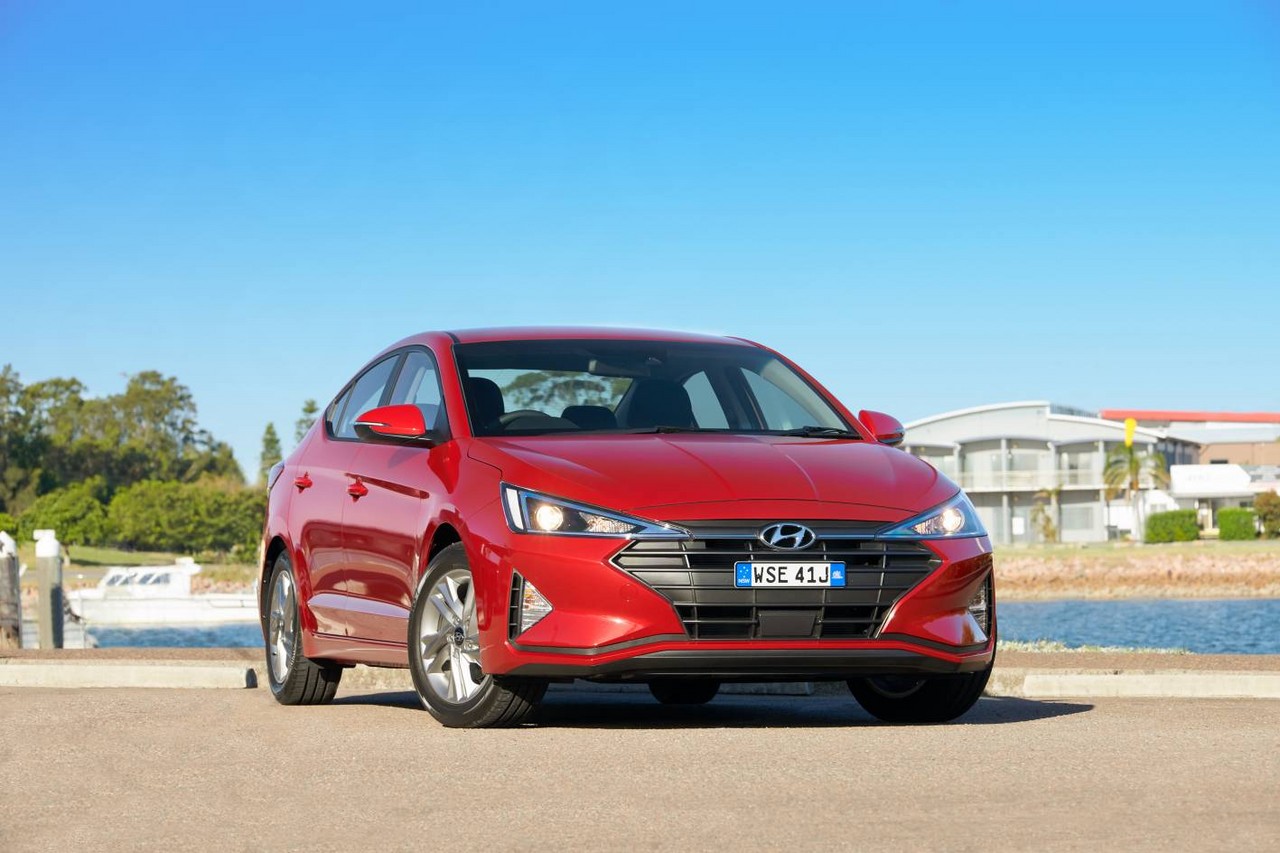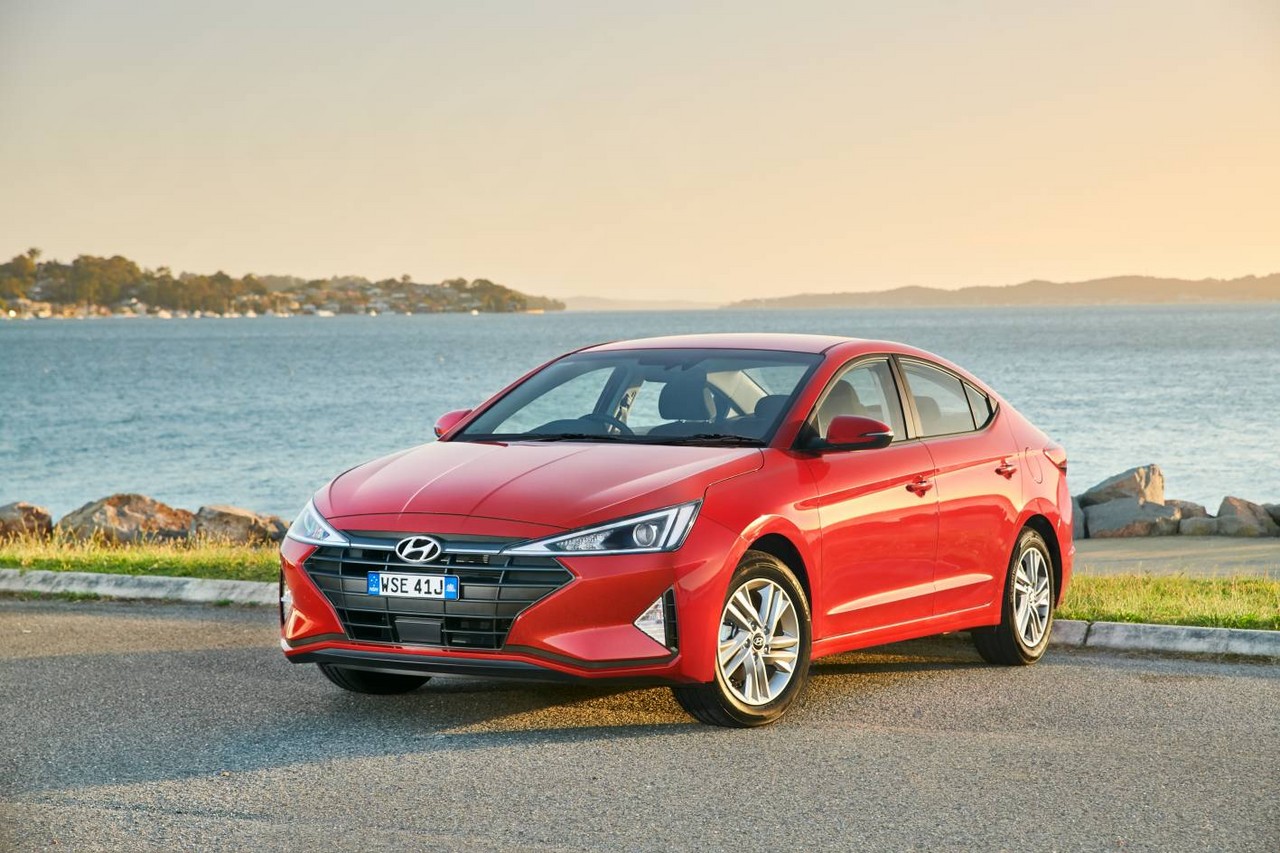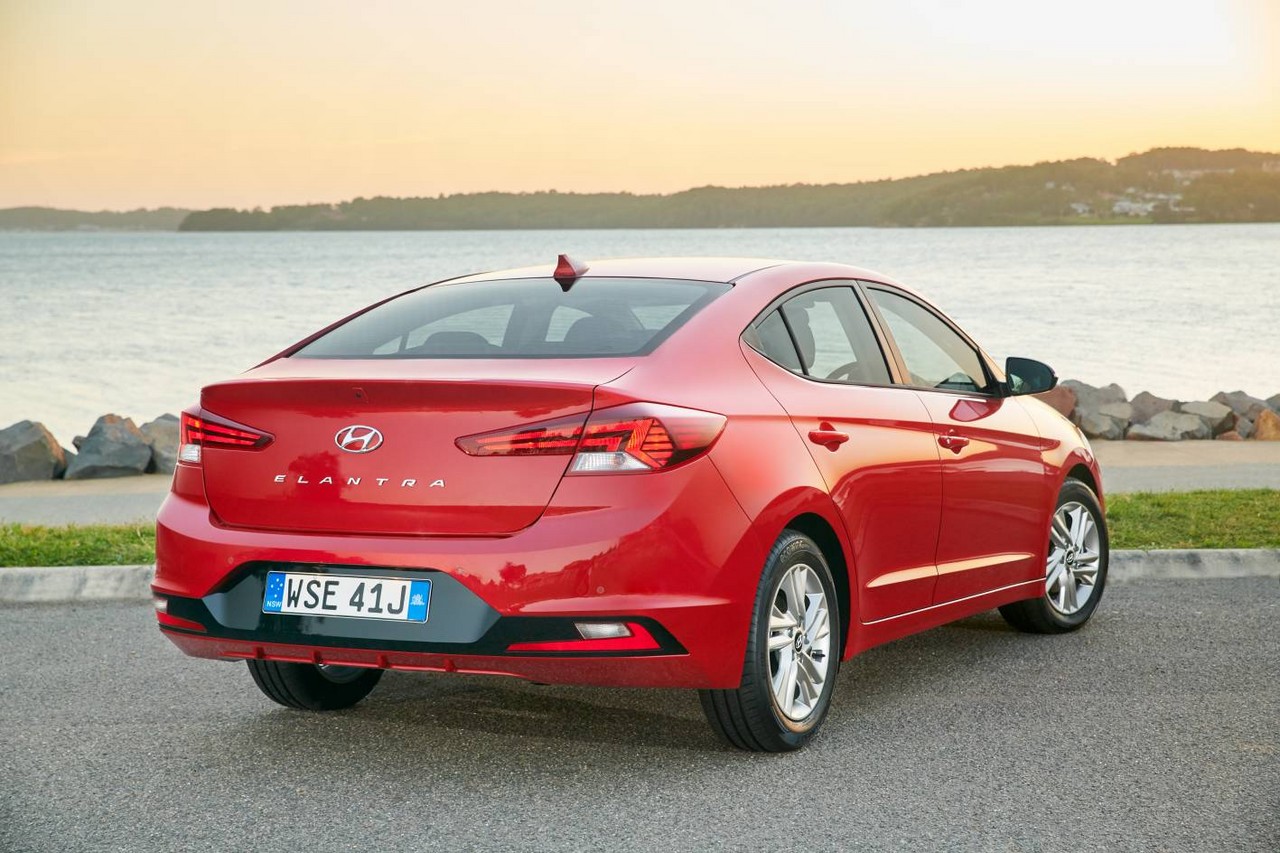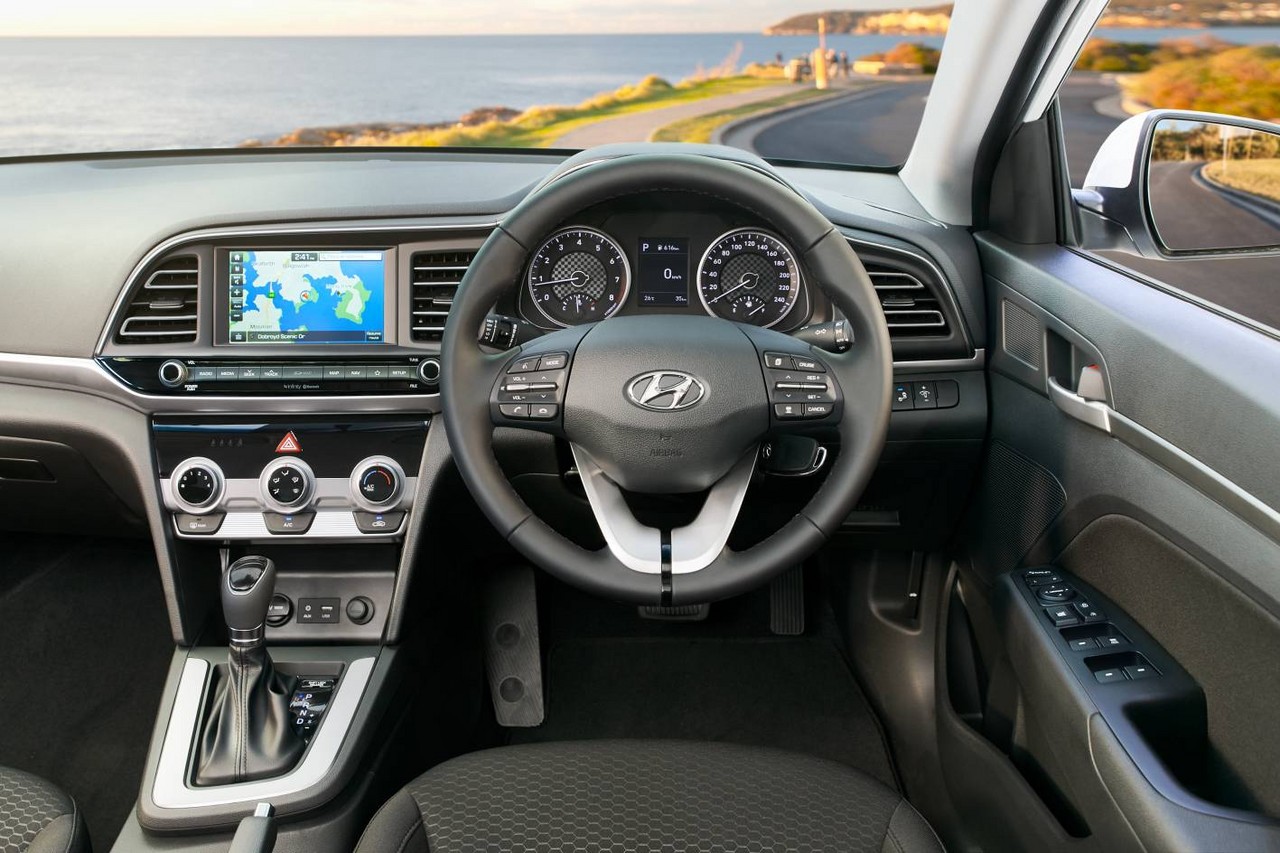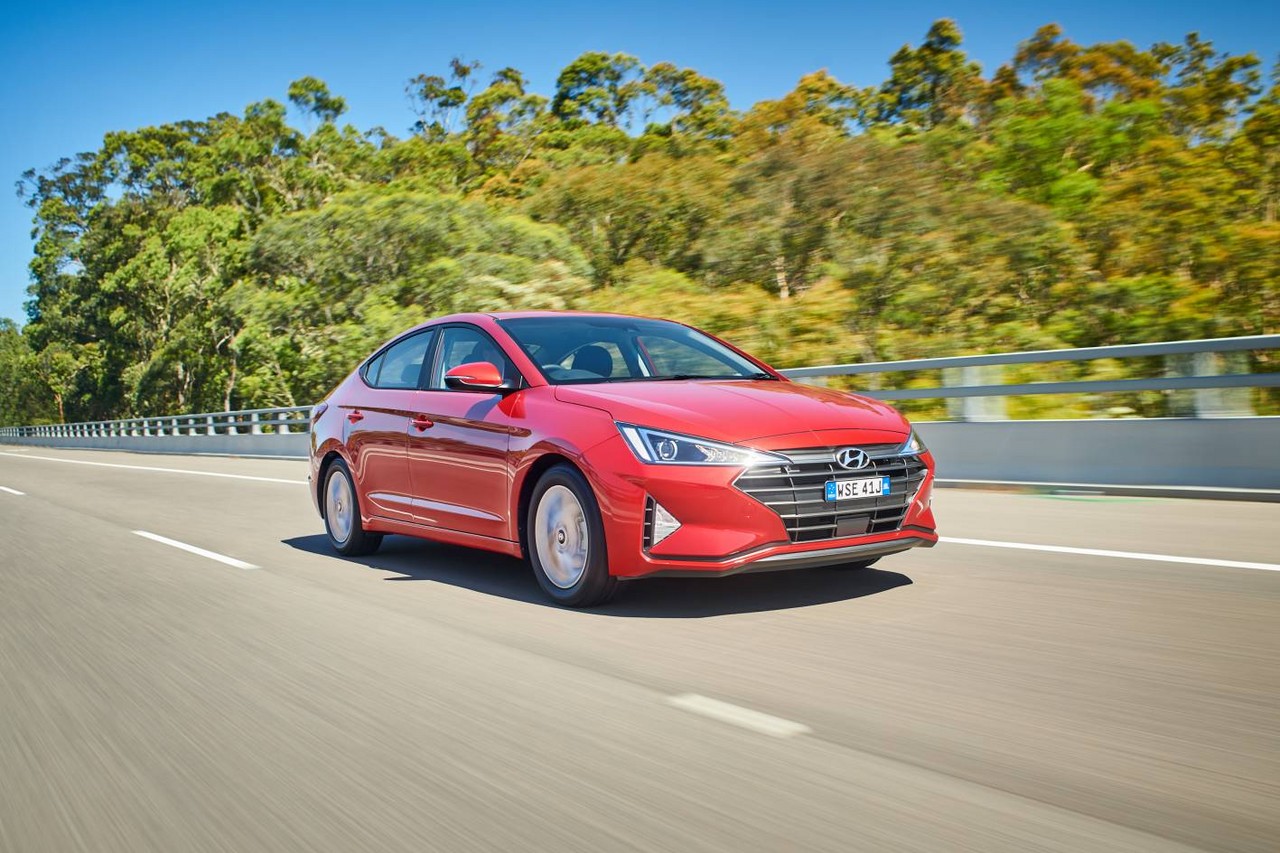
- Accomplished ride/handling balance
- Accurate and well-weighted steering
- Spacious interior…
- … but raked roofline reduces rear seat headroom
- Tyre noise
- Overly sensitive accelerator
- Active safety technologies (like AEB) not fitted as standard
Review: Hyundai AD.I Elantra (2016-18)
Overview
Released in Australia in February 2016, the Hyundai AD Elantra was a front-wheel drive sedan. Manufactured in Ulsan, South Korea, the Hyundai AD Elantra was initially powered by a 2.0-litre petrol engine that was mated to either a six-speed manual or six-speed automatic transmission. Furthermore, the AD Elantra range consisted of Active and Elite editions.
In September 2016, the Hyundai AD Elantra SR Turbo was introduced. As per the table below, the Hyundai Elantra SR Turbo was powered by a 1.6-litre turbocharged petrol engine that was mated to either a six-speed manual or seven-speed double clutch transmission (DCT).
G4NA and G4FJ engines
The Hyundai Elantra’s 2.0-litre G4NA petrol engine was a member of Hyundai’s ‘Nu’ engine family and features an aluminium block and cylinder head, double overhead camshafts, four valves per cylinder, variable intake and exhaust cam timing (Hyundai’s ‘Dual Continuously Variable Valve Timing’ or D-CVVT), a two-stage variable induction system, multi-point injection and a compression ratio of 10.3:1.
For the Elantra SR Turbo, the 1.6-litre G4FJ ‘Gamma’ turbocharged petrol engine had similar properties to the G4NC ‘Nu’ engine, was fitted with a twin-scroll turbocharger, an air-guided intercooler and had a compression ratio of 9.5:1; the G4NC engine also omitted the variable induction system.
| Variant | Edition | Engine | Trans. | Peak power | Peak torque |
|---|---|---|---|---|---|
| 2.0 MPI | Active, Elite |
2.0-litre G4NA petrol I4 | 6sp man., 6sp auto |
112 kW at 6200 rpm | 192 Nm at 4500 rpm |
| 1.6 T-GDi | SR Turbo | 1.6-litre G4FJ turbo petrol I4 | 6sp man., 7sp DCT |
150 kW at 6000 rpm | 265 Nm at 1500-4500 rpm |
Body and dimensions
For the Hyundai AD Elantra, 53 per cent of the chassis consisted of advanced high-strength steels (compared to 21 per cent in the Hyundai MD Elantra ). Furthermore, the amount of structural adhesive applied was increased by 40 times at higher stress points on the chassis and to reinforce welding areas. Other structural developments for the AD Elantra included:
- A hexagonal design for the front side members;
- A straight and continuous load path for the front apron to the A-pillar with hot stamping applied on the front side rear lower member; and,
- For the B-pillar assemblies, partial softening hot stamping that started with a reinforcement section (150 kgf grade) and transitioned into a softening section (100 kgf grade) to better absorb side impacts.
Relative to the Hyundai MD Elantra , the body of the AD Elantra achieved a 29.5 per cent increase in torsional rigidity and a 25.3 per cent increased in bending strength. For greater refinement, the size of the aperture in the front dashboard panel was reduced by 25 per cent, additional sound absorption material was used in all pillars, inner fenders and the floorpan, while thicker front glass was also introduced.
Compared to the Hyundai MD Elantra , the AD Elantra was 21 mm longer (at 4570 mm), 25 mm wider (1800 mm) and 5 mm taller (1440 mm), though wheelbase length (2700 mm) was unchanged. With its underbody covers and front wheel ‘air curtains’, the AD Elantra had a drag coefficient of 0.27 Cd.
Suspension and steering
The Hyundai AD Elantra had MacPherson strut front suspension with coil springs, gas shock absorbers and a stabiliser bar. For the AD Elantra, changes included a new sub-frame with plastic and rubber bushings, and larger bushings on the lower control arms.
For the torsion beam rear suspension, the Hyundai AD Elantra had longer, upright dampers (previously mounted diagonally) and repositioned coil springs; the diameter of the rear bushings was also increased for greater durability. The Hyundai Elantra SR Turbo, however, had multi-link rear suspension.
The Hyundai AD Elantra had rack-and-pinion steering with hydraulic power assistance (Hyundai’s ‘Motor-Driven Power Steering’ or MDPS). The steering wheel required 2.66 turns from lock to lock and provided a turning circle of 10.6 metres.
Safety equipment
Standard safety equipment for the Hyundai AD Elantra included dual front airbags, front side (thorax) airbags, full length curtain airbags (i.e. for front and rear occupants), ABS, brake assist, electronic brake force distribution, electronic stability control, traction control and front seatbelts with pre-tensioners and load limiters.
The Hyundai Elantra SR Turbo was further equipped with:
- Blind Spot Detection (BSD): at speeds above 30 km/h, sonar sensors could detect traffic adjacent to and diagonally behind the vehicle. When a vehicle entered the driver’s blind spot, the driver would receive a visual alert in the corresponding side mirror. If the driver activated an indicator to change lanes when a vehicle was in the detection area, the driver would receive a flashing visual warning and an audible alert;
- Lane Change Assist (LCA): could scan the road behind the AD Elantra to detect vehicles that were rapidly approaching from the rear. If a vehicle was detected, LCA uses the same warning measures as the BSD system to alert the driver; and,
- Rear Cross Traffic Alert (RCTA): active at speeds below 10 km/h, RCTA could detect approaching traffic travelling at speeds from 4 km/h to 36 km/h that may cross the driver’s intended path when reversing. If detected the driver would receive a warning message in the instrument panel and a flashing light in the corresponding door mirror.
ANCAP crash testing
InANCAP crash testing , the Hyundai AD Elantra received a five star adult occupant protection rating with a score of 35.01 out of 37. In the frontal offset test, protection of the front passengers was generally rated as good, though protection of the driver’s chest and lower legs was rated as acceptable (i.e. a slight risk of serious injury). Maximum points, however, were awarded in the side impact and pole tests.
Brakes
The Hyundai AD Elantra 2.0 MPi had 280 mm by 23 mm ventilated front brake discs and 262 mm by 10 mm solid rear discs. The Hyundai Elantra SR Turbo, however, had 305 mm by 25 mm ventilated front brake discs.
Features: Hyundai Elantra Active
Standard features for the Hyundai Elantra Active included 16 x 6.5J alloy wheels with 205/55 R16 tyres, seven-inch touch screen audio system with six speakers, MP3 compatibility, Google Now (Android) voice activation and Apple CarPlay, auxiliary (3.5 mm) and USB audio inputs with iPod compatibility), Bluetooth mobile phone connectivity and audio streaming, cloth seats, air conditioning, cruise control, front fog lights, LED daytime running lights, a rear view camera, rear parking sensors, dusk-sensing headlights, 60:40 split folding rear seats, remote central locking, power adjustable and heated mirrors, power windows, a height adjustable driver’s seat, tilt and telescopic steering column adjustment, a 12 volt power socket (in front of the centre console), a trip computer and immobiliser.
Features: Hyundai Elantra Elite
Relative to the Elantra Active, the Elantra Elite was further equipped with 17 x 7.0J alloy wheels with 225/45 R17 tyres, leather appointed seats, dual-zone climate control air conditioning, rain-sensing wipers, premium steering wheel and gear knob, proximity key (i.e. keyless entry), power folding door mirrors, an electrochromatic rear view mirror, push-button start, hands-free bootlid operation, illuminated vanity mirrors, Hyundai’s ‘Supervision’ cluster with 3.5-inch TFT display, piano black interior trim and a luggage net.
The Hyundai Elantra Elite could be identified by its chrome radiator grille, chrome belt line moulding, door mirrors with integrated LED indicators and LED tail-lights.
Features: Hyundai Elantra SR Turbo
Compared to the Hyundai Elantra Elite, the Elantra SR Turbo omitted front fog lamps, but featured 17 x 7.0J twin-spoke alloy wheels with 225/45 R17 tyres, front sports seats with extended bolsters and red stitching, ten-way power adjustable driver’s seat, heated front seats, bi-xenon headlights, front parking sensors, sports steering wheel with phone controls, power folding door mirrors, a height adjustable front passenger seat, a USB outlet in the centre console storage compartment, black headlining, alloy sports pedals
For models with the double clutch transmission, steering wheel gearshift paddles were also fitted as standard
The Hyundai Elantra SR Turbo could be identified by its sports radiator grille with piano black surround, sports body kit (unique front bumper, rear bumper, rear diffuser and side skirts) and twin exhaust tips. Inside, the centre fascia panels, steering wheel inserts and door handles were a dark charcoal metallic colour, while there were also ‘carbon fibre effect’ dashboard and door inserts.
Unlike the Hyundai Elantra Active and Elite, the Elantra SR Turbo had a temporary (space saver) spare wheel.
Related links
Review: Hyundai AD.II Elantra (2018-on)
Overview
The Hyundai AD Series II (AD.II) Elantra was released in Australia in December 2018. As part of this update, the AD.II Elantra range was revised –
- For the 2.0 MPI variants, an entry-level Go edition was introduced and the Elite edition was discontinued; and,
- For the 1.6 T-GDi variants, the SR Turbo replaced by Sport and Sport Premium editions.
Visually, the Hyundai AD.II Elantra could be identified by its new front mask with redesigned headlights, front indicators that were integrated into the lower lighting array, restyled bonnet with ‘character’ lines, new tail-lights, new bootlid with integrated spoiler and new rear bumper with gloss black inserts and integrated lower diffuser.
Inside, the Hyundai AD.II Elantra had a new dashboard with redesigned air-conditioning outlets and climate control dials, a new steering wheel, a 3.5-inch ‘Supervision’ display within the instrument cluster and new trims and finishes.
| Variant | Edition | Engine | Trans. | Peak power | Peak torque |
|---|---|---|---|---|---|
| 2.0 MPI | Go, Active |
2.0-litre G4NA petrol I4 | 6sp man., 6sp auto |
112 kW at 6200 rpm | 192 Nm at 4500 rpm |
| 1.6 T-GDi | Sport, Sport Premium |
1.6-litre G4FJ turbo petrol I4 | 6sp man., 7sp DCT |
150 kW at 6000 rpm | 265 Nm at 1500-4500 rpm |
Safety equipment
As an extra-cost option, Hyundai AD.II Elantra 2.0 MPI variants with automatic transmissions could be specified with a ‘SmartSense’ safety pack which included the following active safety technologies:
- Autonomous Emergency Braking (AEB) with Front Collision Warning System (FCWS): operating at speeds above 10 km/h, AEB with FCWS used a front radar sensor and camera to monitor the road ahead for vehicles and pedestrians. AEB operates in three stages: 1) initial warnings (visual and acoustic), 2) partial braking and 3) maximum braking when a collision is assessed to be imminent. AEB sought to bring the vehicle to rest if activated at speeds up to 64 km/h for pedestrians and up to 80 km/h for vehicles. At speeds between 80 km/h and 180 km/h, AEB reduced vehicle speed to reduce the severity of the collision;
- Blind-Spot Collision Warning (BCW): operated at speeds above 30 km/h and monitored the rear corners of the vehicle. If another vehicle was detected, a visual alert would appears in the door mirrors;
- Lane Keeping Assist System (LKAS): operating at speeds of 64 km/h and above, LKAS monitored the vehicle’s position within its lane;
- Rear Cross-Traffic Collision Warning (RCCW): used radar sensors to scan a 180 degree area behind the vehicle for traffic that may cross the vehicle’s path as it reversed out of a parking space. If detected, visual and acoustic signals would alert the driver;
- Smart Cruise Control (SCC): using front radar sensors, SCC enabled a constant speed and/or distance to be maintained from the vehicle ahead without requiring the driver to apply the accelerator or brake pedals. Furthermore, SCC automatically ceased operating when vehicle speed dropped to 10 km/h or below; and,
- Driver Attention Warning (DAW): operating at speeds of 64 km/h and above, DAW monitored steering angle, steering torque, vehicle position within its lane and driving patterns to detect reckless or fatigued driving. If the system detected inattentive driving, an audible tone and message would appear on the instrument display panel to alert the driver. The driver can also adjust the system’s sensitivity.
Features: Hyundai AD.II 2.0 MPI Elantra Go and Active
Standard features for the Hyundai Elantra Go included 15-inch steel wheels with 195/65 R15 91H tyres, a six speaker sound system, seven-inch touchscreen, Apple CarPlay and Android Auto smartphone integration, Bluetooth mobile phone connectivity and audio streaming, cruise control, projector beam headlights with dusk-sensing function, a rear view camera with dynamic guide lines, remote central locking, power adjustable and heated mirrors, power windows, tilt and telescopic steering wheel adjustment, a height adjustable driver’s seat, a 12 volt power socket (centre console), a trip computer and an immobiliser.
As standard, the AD.II Elantra was equipped with ‘Hyundai Auto Link’ which enabled owners to access the Elantra’s ‘smart computer’ through their mobile phones (via Bluetooth) to monitor vehicle data such as real-time diagnostics, tyre pressure, driving history statistics, parking management, service scheduling and access to roadside assistance.
Compared to the Elantra Go, the Elantra Active was further equipped with 16-inch alloy wheels with 205/55 R16 91H tyres, an eight speaker Infinity sound system with external amplifier, a digital radio tuner (DAB+), an eight-inch touchscreen, satellite navigation with SUNA live traffic updates, rear parking sensors, a leather steering wheel and gear knob, power folding door mirrors with auto fold function and vanity mirrors.
Features: Hyundai AD.II Elantra 1.6 T-GDi Sport and Sport Premium
Information regarding features for the Hyundai AD.II Elantra 1.6 T-GDi Sport and Sport Premium is expected to be announced in earlier 2019.
Specification
